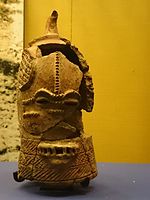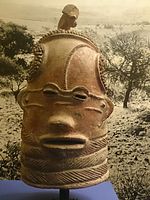User:DarthNonahs/sandbox
| DarthNonahs/sandbox | |
|---|---|
 The Lydenburg heads are the earliest known examples of African sculpture in Southern Africa. | |
 | |
| Material | terracotta |
| Created | African Iron Age A.D. 500 |
| Discovered | Lydenburg, Mpumalanga, South Africa |
| Present location | Iziko South African Museum, Cape Town |
The Lydenburg heads refer to seven terracotta heads were discovered in association with other pottery artifacts in Lydenburg, Mpumalanga, South Africa. They are among the oldest known African Iron Age artworks from below the equator.[1] Other artifacts found in association with these heads include ceramic vessels, iron and copper beads, and bone fragments. Charcoal associated with the head was Radiocarbon dated, and this relative dating technique places these artifacts and the site at around 1500 years old, which constitutes one of the earliest dates for Iron Age Settlement in South Africa.[2]
Discovery
[edit]The heads were discovered by a young boy named Ludwig Von Benzing while playing on his fathers farm and collected when Ludwig was a teenager.[3] He went back in both 1962 and 1966 to excavate the area and during this time he was able to find several pieces of pottery that proved to be seven heads when assembled, two of which can fit over a child's head; only one out of the seven heads resembles an animal.[1]
Artifacts
[edit]
The recovered pottery sherds were reconstructed largely at the University of Cape Town, and assembled to comprise two large heads and five smaller heads. One of the larger heads constitute an incomplete specimen.[4] The reconstructed heads provide a glimpse into the craftsmen's skill and preciseness of artistry, even though they may not look exactly how they looked 1500 years ago. Six of the heads share human characteristics, while a single head has animal-like features. The presence of linear patterned neck rings are postulated to represent a marker of prosperity or wealth, due to their symbolic use throughout time.[5] Of the seven, only two are large enough to have been worn, but the size is not the only observable variation between them. The two aforementioned heads constitute the only specimens with small animal figurines, perceived to be lions, mounted on top of them.[5] The other five are more similar in size and appearance, with one exception. This head is the only head that seems to resemble something other than a human. It has a long snout instead of regular protruding lips and also has no ears.[6] Documentation of associated artifacts was limited due to the primary significance of the heads; however, we do know that the associated pottery sherds were identified as terracotta.
Head Characteristics
[edit]The base formed at the bottom of the all the heads was completed like the rim of a pot. Parts of the rim are rounded, however some parts of the base reflects a flat squared shape. While the Basal rings may be incised or molded the neck rings above these basal rings contain diagonally incised rings that circle the entire neck. The incesed pattern constitutes hatch marks that alternate in direction producing a herringbone pattern.[4]
Head #1
[edit]The basal neck rings are molded.
Head #2
[edit]The basal neck rings are molded
Head #3
[edit]The basal neck rings are incised.
Head #4
[edit]The basal neck rings are insiced.
Head #5
[edit]The basal neck rings are incised
Head #6
[edit]The basal neck rings are inciesed
Head #7
[edit]The basal neck rings are incised.
Speculative Purpose
[edit]
The current speculation surrounding the Lydenburg Heads is that they may have been created to serve ritualistic and or ceremonial purposes including initiation rights.[6] The two larger specimens could have been worn by a small individual such as young man. If so, these heads may represent a significant point in a boy's life such as becoming a man, or ceremonial purposes like memorializing an ancestor.[5] The five smaller heads have holes in their sides which some archaeologists suggest may have been used to connected them to something at the time of their use.[6] However some people believe that the marks across the foreheads and between the eyes are that of sacrificial marks and others think that the heads may not have been just disposed of but purposely buried.[7] This may have been for ceremonial purposes or to even celebrate their ancestors.
See also
[edit]References
[edit]- ^ a b "Lydenburg Heads (ca. 500) | Thematic Essay | Heilbrunn Timeline of Art History | The Metropolitan Museum of Art". www.metmuseum.org. Retrieved 2015-12-09.
- ^ Whitelaw, Gavin (1996). "Lydenburg Revisited: Another Look at The Mpumalanga Early Iron Age Sequence". The South African Archaeological Bulletin.
- ^ Inskeep, R. R.; Maggs, T. M. O'C. (1975-01-01). "Unique Art Objects in the Iron Age of the Transvaal, South Africa". The South African Archaeological Bulletin. 30 (119/120): 114–138. doi:10.2307/3888099.
- ^ a b Inskeep, R.R. (May 1975). "Unique Art Objects In The Iron Age Of The Transvall, South Africa". South African Archaeological Bulletin.
- ^ a b c Maggs, Tim; Davison, Patricia (1981-02-01). "The Lydenburg Heads". African Arts. 14 (2): 28–88. doi:10.2307/3335725.
- ^ a b c "Lydenburg Heads (ca. 500)". Timeline of Art History. Metropolitan Museum of Art. October 2003. Retrieved 2015-12-09.
- ^ "Mysterious Creators Of Lydenburg Heads - MessageToEagle.com". www.messagetoeagle.com. Retrieved 2015-12-09.
